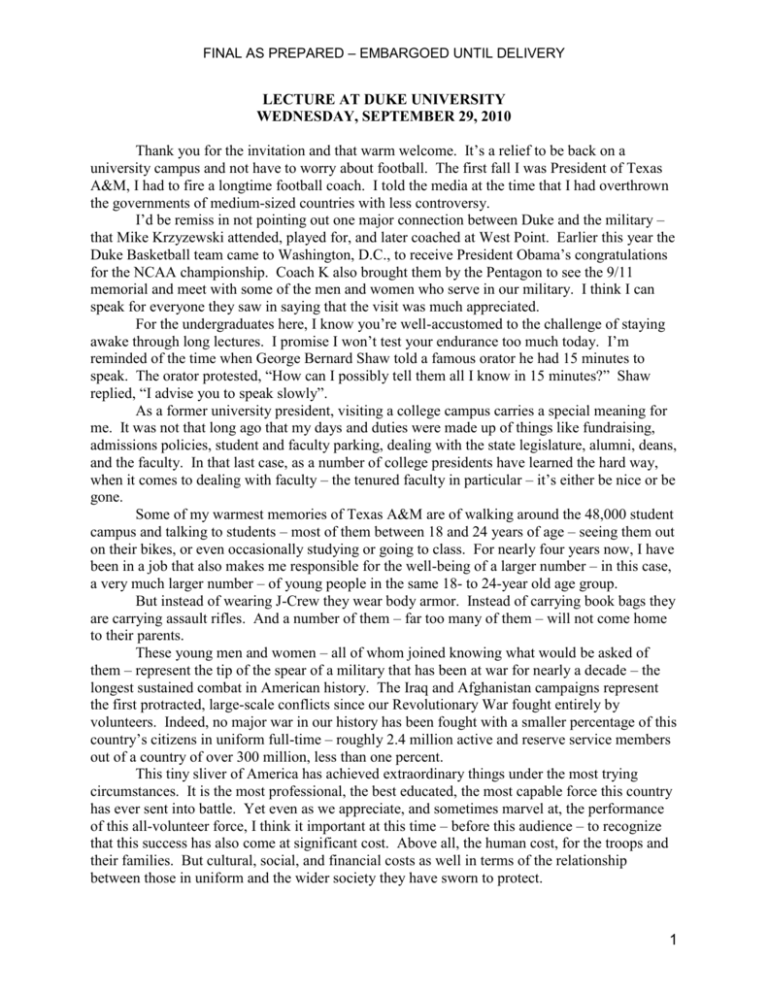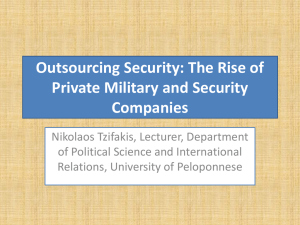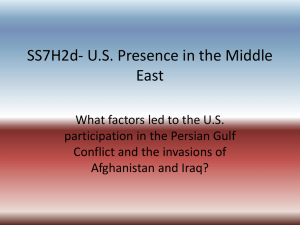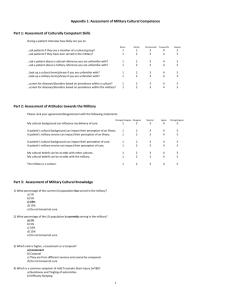LECTURE AT DUKE UNIVERSITY
advertisement

FINAL AS PREPARED – EMBARGOED UNTIL DELIVERY LECTURE AT DUKE UNIVERSITY WEDNESDAY, SEPTEMBER 29, 2010 Thank you for the invitation and that warm welcome. It’s a relief to be back on a university campus and not have to worry about football. The first fall I was President of Texas A&M, I had to fire a longtime football coach. I told the media at the time that I had overthrown the governments of medium-sized countries with less controversy. I’d be remiss in not pointing out one major connection between Duke and the military – that Mike Krzyzewski attended, played for, and later coached at West Point. Earlier this year the Duke Basketball team came to Washington, D.C., to receive President Obama’s congratulations for the NCAA championship. Coach K also brought them by the Pentagon to see the 9/11 memorial and meet with some of the men and women who serve in our military. I think I can speak for everyone they saw in saying that the visit was much appreciated. For the undergraduates here, I know you’re well-accustomed to the challenge of staying awake through long lectures. I promise I won’t test your endurance too much today. I’m reminded of the time when George Bernard Shaw told a famous orator he had 15 minutes to speak. The orator protested, “How can I possibly tell them all I know in 15 minutes?” Shaw replied, “I advise you to speak slowly”. As a former university president, visiting a college campus carries a special meaning for me. It was not that long ago that my days and duties were made up of things like fundraising, admissions policies, student and faculty parking, dealing with the state legislature, alumni, deans, and the faculty. In that last case, as a number of college presidents have learned the hard way, when it comes to dealing with faculty – the tenured faculty in particular – it’s either be nice or be gone. Some of my warmest memories of Texas A&M are of walking around the 48,000 student campus and talking to students – most of them between 18 and 24 years of age – seeing them out on their bikes, or even occasionally studying or going to class. For nearly four years now, I have been in a job that also makes me responsible for the well-being of a larger number – in this case, a very much larger number – of young people in the same 18- to 24-year old age group. But instead of wearing J-Crew they wear body armor. Instead of carrying book bags they are carrying assault rifles. And a number of them – far too many of them – will not come home to their parents. These young men and women – all of whom joined knowing what would be asked of them – represent the tip of the spear of a military that has been at war for nearly a decade – the longest sustained combat in American history. The Iraq and Afghanistan campaigns represent the first protracted, large-scale conflicts since our Revolutionary War fought entirely by volunteers. Indeed, no major war in our history has been fought with a smaller percentage of this country’s citizens in uniform full-time – roughly 2.4 million active and reserve service members out of a country of over 300 million, less than one percent. This tiny sliver of America has achieved extraordinary things under the most trying circumstances. It is the most professional, the best educated, the most capable force this country has ever sent into battle. Yet even as we appreciate, and sometimes marvel at, the performance of this all-volunteer force, I think it important at this time – before this audience – to recognize that this success has also come at significant cost. Above all, the human cost, for the troops and their families. But cultural, social, and financial costs as well in terms of the relationship between those in uniform and the wider society they have sworn to protect. 1 FINAL AS PREPARED – EMBARGOED UNTIL DELIVERY So for the next few minutes, I’d like to discuss the state of America’s all-volunteer force, reflecting on its achievements while at the same time considering the dilemmas and consequences that go with having so few fighting our wars for so long. These are issues that must be acknowledged, and in some cases dealt with, if we are to sustain the kind of military America needs in this complex and, I believe, even more dangerous and unstable new century. First, some brief historical context. From America’s founding until the end of World War II, this country maintained small standing armies that would be filled out with mass conscription in the case of war. Consider that in the late 1930s, even as World War II loomed, the U.S. Army ranked 17th in the world in size, right below Romania. That came to an end with the Cold War, when America retained a large, permanent military by continuing to rely on the draft even in peacetime. Back then, apart from heroism on the battlefield, the act of simply being in the military was nothing extraordinary or remarkable. It was not considered a sign of uncommon patriotism or character. It was just something a healthy young man was expected to do if called on, just as his father and grandfather had likely done in the two world wars. Among those who ended up in the military in those early years of the Cold War were people like Elvis Presley and Willie Mays, movie stars, future congressmen, business executives. The possibility of being drafted encouraged many to sign up so they could have more control over their fate. As I can speak from experience, the reality of military service – and whether to embrace, avoid, or delay it – was something most American men at some point had to confront. The ethos of service reinforced by the strong arm of compulsion extended to elite settings as well. A prominent military historian once noted that of roughly 750 of his classmates in the Princeton University class of 1956, more than 400 went on to some form of military service – a group that included a future Harvard President, governor of Delaware, and Pulitzer Prize winning reporter for the New York Times. That same year, more than 1,000 cadets were trained by Stanford University’s ROTC program. The controversy associated with the Vietnam War and the bitterness over who avoided the draft and who did not, led to a number of major changes in our military and American society. One of them was the end of conscription and the beginning of the All Volunteer Force under President Nixon. Over the past four decades, after a difficult transition period during the 1970s, the allvolunteer experiment has proven to be a remarkable success. The doubts – and there were many inside and outside the military– were largely overcome. Indeed, the United States would not be able to sustain complex, protracted missions like Iraq and Afghanistan at such a high standard of military performance without the dedication of seasoned professionals who chose to serve – and keep on serving. Whatever the shortcomings there have been in Iraq and Afghanistan stemmed from failures and miscalculations at the top, not those doing the fighting and leading on the ground. It has taken every ounce of our troops’ skill, initiative and commitment to battle a cunning and adaptive enemy at the front while overcoming bureaucratic lassitude and sometimes worse at the rear. A key factor in this success is experience. Consider that, according to one study, in 1969 less than 20 percent of enlisted Army soldiers had more than four years of service. Today, it is more than 50 percent. Going back to compulsory service, in addition to being politically impossible, is highly impractical given the kinds of technical skills, experience, and attributes needed to be successful on the battlefield in the 21st century. For that reason, reinstituting the draft is overwhelmingly opposed by the military’s leadership. 2 FINAL AS PREPARED – EMBARGOED UNTIL DELIVERY Nonetheless, we should not ignore the broader, long-term consequences of waging these protracted military campaigns employing – and re-employing – such a small portion of our society in the effort. First, as a result of the multiple deployments and hardships associated with Afghanistan and Iraq, large swaths of the military – especially our ground combat forces and their families– are under extraordinary stress. The all volunteer force conceived in the 1970s was designed to train, prepare, and deploy for a major – and quick – conventional conflict – either against the Soviet Union on the plains of Central Europe or a contingency such as the first gulf war against Iraq in 1991. In that instance – and I remember it well as I was Deputy National Security Advisor at the time – more than half a million U.S. troops were deployed, fought, and mostly returned home within one year. By contrast, the recent post-9/11 campaigns have required prolonged, persistent combat and support from across the military. Since the invasion of Iraq, more than 1 million soldiers and Marines have been deployed into the fight. The Navy has put nearly 100,000 sailors on the ground while maintaining its sea commitments around the globe. And the Air Force, by one count, has been at war since 1991, when it first began enforcing the no-fly zone over Iraq. U.S. troops and their families have held up remarkably well given the demands and pressures placed on them. With the exception of the Army during the worst stretch of the Iraq war, when it fell short of recruiting targets and some measures of quality declined, all the services have consistently met their active recruiting and retention goals. In some cases the highest propensity to re-enlist is found in units that are in the fight. When I visited Camp Lejeune last year – a Marine Corps base about 150 miles from Durham – an officer told me about one unit whose assignment was switched from Japan to Afghanistan. As a result, about 100 Marines who were planning to get out of the military decided to sign up again so they could deploy with their buddies. The camaraderie and commitment is real. But so is the strain. On troops, and especially on their families. I know – I hear it directly during my trips to Army and Marine bases across this country, where spouses and children have had their resilience tested by the long and frequent absences of a father, mother, husband or wife. There are a number of consequences that stem from the pressure repeated deployments – especially when a service member returns home sometimes permanently changed by their experience. These consequences include more anxiety and disruption inflicted on children, increased domestic strife and a corresponding rising divorce rate, which in the case of Army enlisted has nearly doubled since the wars began. And, most tragically, a growing number of suicides. While we often speak generally of a force under stress, in reality, it is certain parts of the military that have borne the brunt of repeat deployments and exposure to fire – above all, junior and mid-level officers and sergeants in ground combat and support specialties. These young men and women have seen the complex, grueling, maddening face of asymmetric war in the 21st century up close. They’ve lost friends and comrades. Some are struggling psychologically with what they’ve seen, and heard and felt on the battlefield. And yet they keep coming back. This cadre of young regular and non-commissioned officers represents the most battletested, innovative and impressive generation of military leaders this country has produced in a long time. These are the people we need to retain and lead the armed forces in the future. But no matter how patriotic, how devoted they are, at some point they will want to have the 3 FINAL AS PREPARED – EMBARGOED UNTIL DELIVERY semblance of a normal life – getting married, starting a family, going to college or grad school, seeing their children grow up – that they have justly earned. Measures such as growing the size of the Army and Marines, increasing what is called “dwell time” at home, drawing down in Iraq, and beginning a gradual transition next year in Afghanistan should reduce this stress over time. Properly funded support programs to help troops and families under duress – the kind championed by our First Lady – can also make a difference. But in reality, the demands on a good part of our military will continue for years to come. And, it begs the question: How long can these brave and broad young shoulders carry the burden that we – as a military, as a government, as a society – continue to place on them? There is also a question – and it is an uncomfortable and politically fraught question – of the growing financial costs associated with an all volunteer force. Just over the past decade – fueled by increasing health costs, pay raises, and wartime recruiting and retention bonuses – the amount the military spends on personnel and benefits has nearly doubled: From roughly $90 billion in 2001 to just over $170 billion this year out of a $534 billion defense budget. The health care component has grown even faster, from $19 billion a decade ago to more than $50 billion this year, a portion of that total going to working-age retirees whose premiums and copays have not increased in some 15 years. To be clear, we must spare no expense to compensate or care for those who have served and suffered on the battlefield. That is our sacred obligation. But given the enormous fiscal pressures facing the country, there is no avoiding the challenge this government, indeed this country faces, to come up with an equitable and sustainable system of military pay and benefits that reflects the realities of this century. A system generous enough to recruit and retain the people we need and to do right by those who’ve served – but not one that puts the Department of Defense on the same path as other industrial age organizations that sank under the weight of their personnel costs. The political resistance to confronting these costs is understandable, given the American people’s gratitude towards their countrymen who have chosen to serve. This nation has come a long way from the late 1960s and early 1970s, when too many returning Vietnam veterans were met with sullen indifference or worse – especially in cosmopolitan or academic enclaves. Today, in airports all over the country, troops returning or leaving for Afghanistan or Iraq receive standing ovations from other passengers. Welcome home parades, letters and care-packages, free meals, drinks, and sports tickets – all heartfelt signs of appreciation large and small that bridge the political divide. Veterans of our wars are also welcomed to campuses all across America as they return to school. It is also true, however, that whatever their fond sentiments for men and women in uniform, for most Americans the war remains an abstraction. A distant and unpleasant series of news items that does not affect them personally. Even after 9/11, in the absence of a draft, for a growing number of Americans, service in the military, no matter how laudable, has become something for other people to do. In fact, with each passing decade fewer and fewer Americans know someone with military experience in their family or social circle. According to one study, in 1988 about 40 percent of 18 year olds had a veteran parent. By 2000 the share had dropped to 18 percent, and is projected to fall below 10 percent in the future In broad demographic terms, the Armed Forces continue to be largely representative of the country as a whole – drawing predominantly from America’s working and middle classes. There are disparities when it comes to the racial composition of certain specialties and ranks, especially the most senior officers. But in all, the fears expressed when the all volunteer force 4 FINAL AS PREPARED – EMBARGOED UNTIL DELIVERY was first instituted – that the only people left willing to serve would be the poorest, the worst educated, the least able to get any other job – simply did not come to pass. As I alluded to earlier, that group would be hard pressed to make it into a force that, on average, is the most educated in history. Where virtually all new enlistees have a high school diploma or equivalent – about 15 percent more than their civilian peers – and nearly all officers have bachelors’ degrees, many have Masters, and a surprising number, like General David Petraeus, have PhDs. At the same time, an ever growing portion of America’s 17 to 24 year olds – about75% – is simply ineligible or unavailable to serve for a variety of reasons – above all health and weight requirements in an age of spiraling childhood obesity. Having said that, the nearly four decades of all-volunteer force has reinforced a series of demographic, cultural, and institutional shifts affecting who is most likely to serve and from where. Studies have shown that one of the biggest factors in propensity to join the military is growing up near those who have or are serving. In this country, that propensity to serve is most pronounced in the South and Mountain West, and in rural areas and small towns nationwide – a propensity that well exceeds these communities’ portion of the population as a whole. Concurrently, the percentage of the force from the Northeast, West Coast, and major cities continues to decline. I am also struck by how many young troops I meet grew up in military families, and by the large number of our senior officers whose children are in uniform – including the recent commander of all U.S. Forces in Iraq whose son was seriously wounded early in the war. The military’s own basing and recruiting decisions have reinforced this growing concentration among certain regions and families. With limited resources, the services will focus their recruiting efforts on candidates where they are most likely to have success – with those whose friends, classmates, and parents have already served. In addition, global basing changes in recent years have moved a significant percentage of the Army to posts in just five states: Texas, Washington, Georgia, Kentucky, and here in North Carolina. For otherwise rational environmental and budgetary reasons, many military facilities in the northeast and west coast have been shut down, leaving a void of relationships and understanding of the armed forces in their wake. This trend also affects the recruiting and educating of new officers. The state of Alabama, with a population less than 5 million, has 10 Army ROTC host programs. The Los Angeles metro area, population over 12 million, has four host ROTC programs. The Chicago metro area, population 9 million, has 3. It makes sense to focus on places where space is ample and inexpensive, where candidates are most inclined sign up and pursue a career in uniform. But there is a risk over time of developing a cadre of military leaders that politically, culturally, and geographically have less and less in common with the people they have sworn to defend. I’d like to close by speaking about another narrow sliver of our population, those attending and graduating from our nation’s most selective and academically demanding universities, such as Duke. In short, students like you. Over the past generation many commentators have lamented the absence of ROTC from the Ivy League and other selective universities. Institutions that used to send hundreds of graduates into the armed forces, but now struggle to commission a handful of officers every year. University faculty and administrators banned ROTC from many elite campuses during the Vietnam War and continued to bar the military based on the Don’t Ask Don’t Tell policy – with Duke being a notable and admirable exception with your three host programs. I am encouraged that several other comparable universities – with the urging of some of their most prominent alumni, including the President of 5 FINAL AS PREPARED – EMBARGOED UNTIL DELIVERY the United States – are at least re-considering their position on military recruiting and officer training – a situation that has been neither good for the academy or the country. But a return of ROTC back to some of these campuses will not do much good without the willingness of our nation’s most gifted students to step forward. Men and women such as you. One does not need to look too hard to find Duke exemplars of selflessness and sacrifice. Consider the story of Jonathan Kuniholm, currently a Duke graduate student in biomedical engineering, who lost part of his arm as Marine reservist in Iraq. Now he is putting his experience and expertise to work designing new prosthetics – work that will help other amputees in and out of uniform. There is Eric Greitens, class of 1996, Rhodes Scholar, Navy Seal. After narrowly missing injury himself during a mission in Iraq, he came back home and founded the nonprofit “The Mission Continues” to help wounded troops and veterans continue serving in some capacity. And last year, when it came time to reshape and reform the half-trillion dollar enterprise known as the Department of Defense, the person whose counsel I relied on to make the toughest budget decisions was Lieutenant General Emo Gardner, career Marine Corps aviator, Duke class of 1973. No doubt, when it comes to military service, one can’t hide from the downsides: The frustration of grappling with a huge, and frequently obtuse bureaucracy. Frequent moves to places that aren’t exactly tourist destinations or cultural hubs. Separation from loved ones. The fatigue, loneliness and fear on a distant dusty outpost thousands of miles from home. And then there is the danger and the risk. Next to the sidewalk between your chapel and the divinity school there is an unobtrusive stone wall. For decades the only names on it were your alumni killed in World War II. Last October 54 names were added to the wall for those Duke men and women who died in the wars since then, including two who made the ultimate sacrifice in Iraq. Matthew Lynch, class of 2001, champion swimmer, following in his father's footsteps as a United States Marine. And, James Regan, class of 2002, son of an investment banker who turned down offers from a financial services firm and a law firm to join the army rangers. But beyond the hardship and heartbreak – and they are real – there is another side to military service. That is the opportunity to be given extraordinary responsibility at a young age – not just for lives of your troops, but for missions and decisions that may change the course of history. In addition to being in the fight, our young military leaders in Iraq and Afghanistan, have to one degree or another found themselves dealing with development, governance, agriculture, and diplomacy. They’ve done all this at an age when many of their peers are reading spreadsheets and making photocopies. And that is why, I should add, they are often in such high demand with future employers and go on to do great things – in scholarship, in government, in business – in every walk of life. So I would encourage you and all young Americans, especially those at the most selective universities who may not have considered the military, to do so. To go outside your comfort zone and take a risk in every sense of the word. To expand what you thought you were capable of doing when it comes to leadership, responsibility, agility, selflessness, and above all, courage. For those for whom military service is neither possible or the right thing for whatever reason, please consider how you can give back to the country that has given us all so much. 6 FINAL AS PREPARED – EMBARGOED UNTIL DELIVERY Think about what you can do to earn your freedom – freedom paid for by those whose names are on that Duke wall and in veterans’ cemeteries across this country and across the world. I would leave you with one of my favorite quotes from John Adams. In a letter that he sent to his son, he wrote, “Public business, my son, must always be done by somebody. It will be done by somebody or another. If wise men decline it, others will not; if honest men refuse it, others will not.” Will the wise and honest here at Duke come help us do the public business of America? Because, if America’s best and brightest young people will not step forward, who then can we count on to protect and sustain the greatness of this country in the 21st century? Thank you. ### 7






